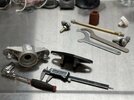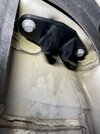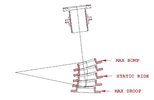Welcome to Tesla Motors Club
Discuss Tesla's Model S, Model 3, Model X, Model Y, Cybertruck, Roadster and More.
Register
Install the app
How to install the app on iOS
You can install our site as a web app on your iOS device by utilizing the Add to Home Screen feature in Safari. Please see this thread for more details on this.
Note: This feature may not be available in some browsers.
-
Want to remove ads? Register an account and login to see fewer ads, and become a Supporting Member to remove almost all ads.
You are using an out of date browser. It may not display this or other websites correctly.
You should upgrade or use an alternative browser.
You should upgrade or use an alternative browser.
True coilover rear possible on Model 3?
- Thread starter Motion122
- Start date
Gauss Guzzler
Safety Score = 42
What's the motivation? The divorced coil was chosen for packaging reasons and the structure was designed accordingly. By switching to coilover you're putting loads where they weren't intended without recovering any usable space.
Is there some theory that coilovers inherently perform better or are you just wanting to install a system that was designed for a different car?
Is there some theory that coilovers inherently perform better or are you just wanting to install a system that was designed for a different car?
You're reinventing the wheel. There are 3rd party kits that have rear coil overs, and they are pretty much universally panned because the Model 3/Y chassis was not designed to have the load of the car on the shock mounts. Time to cut your losses.
BuzzinAround
Member
As mentioned by all before me, this would be adding stresses to a part of the car not designed to hold that much stress.
Potentially less stress on the subframe bushings and the sheetmetal around the subframe mounts, but more on the shock towers. Will likely need to reinforce the towers or run a cage.What's the motivation? The divorced coil was chosen for packaging reasons and the structure was designed accordingly. By switching to coilover you're putting loads where they weren't intended without recovering any usable space.
Is there some theory that coilovers inherently perform better or are you just wanting to install a system that was designed for a different car?
More consistent spring rates(no spikes) since there will no longer be bending of the springs(unless someone designs an articulating weight jack) due to their current location between the lower camber link and the frame of the vehicle and the arc the lower camber link must travel through.
You can also swap this coilover setup(spring and shock) in minutes.
For coilover type linear rate springs thus the mention of weight jacks above.I doubt it's possible to reinforce this location enough to keep stock consistency. I also don't believe that stock size spring can bend.
MasterC17
Active Member
I guess the question is - why? The chances you are going to find any improvement are slim to none. And, in the process, you are doing irreversible modifications to the car, spending money and time, and possibly making it a lot worse. I don't see the value.
Gauss Guzzler
Safety Score = 42
And FYI you are correct in that the divorced rear spring "bends" like an accordion as it follows the arc of the lower control arm. But that doesn't make it nonlinear - springs tend to be linear no matter which way you deform them.
What makes it nonlinear is that every part of the suspension - including the wheel and shock - follow an arced path around the control arm but you are only interested in the vertical component of that motion. So the difference between the vertical displacement that you care about and the arced path that the wheel actually takes is what makes the spring rate appear nonlinear.
So if you follow the two points above you'll see that a coilover is just as nonlinear as a divorced spring even though the spring itself is being guided linearly by the shock. Fortunately this nonlinearity is miniscule and is of no consequence to anyone other than academics.
A divorced spring is generally undesirable nonetheless. It occupies more space, requires twice as many chassis mounting points, requires the lower control arm to be much stronger/wider/heavier, and increases NVH by requiring stiffer lower control arm bushings to withstand the constant 750lb force of the spring. No other suspension bushings are subjected to constant forces like that.
Tesla once had grander plans for the Model 3 and it seems they chose the divorced spring setup because it provided space for ludicrously wide rear tires (and also the design could carry forward to the Y for increased cargo bay width).

What makes it nonlinear is that every part of the suspension - including the wheel and shock - follow an arced path around the control arm but you are only interested in the vertical component of that motion. So the difference between the vertical displacement that you care about and the arced path that the wheel actually takes is what makes the spring rate appear nonlinear.
So if you follow the two points above you'll see that a coilover is just as nonlinear as a divorced spring even though the spring itself is being guided linearly by the shock. Fortunately this nonlinearity is miniscule and is of no consequence to anyone other than academics.
A divorced spring is generally undesirable nonetheless. It occupies more space, requires twice as many chassis mounting points, requires the lower control arm to be much stronger/wider/heavier, and increases NVH by requiring stiffer lower control arm bushings to withstand the constant 750lb force of the spring. No other suspension bushings are subjected to constant forces like that.
Tesla once had grander plans for the Model 3 and it seems they chose the divorced spring setup because it provided space for ludicrously wide rear tires (and also the design could carry forward to the Y for increased cargo bay width).
thesmokingman
Active Member
gearchruncher
Well-Known Member
Doesn't moving to a coil over then lead to bending load of the shock and thus less linear shock behavior due to the way a spring compresses? It's a tradeoff...

 www.hypercoils.com
www.hypercoils.com

Hydraulic Spring Perches | Spring Seats | Hyperco
Hyperco’s Hydraulic Spring Perches are suspension components used on coil-over springs to minimize lateral forces, resulting in max vehicle performance.
This is a good start on a potential structural disaster, with high likelihood of structural failure. Why would you think that this has any assurance of being safe?This is a good start. Clevis mount made and test fit is a success!
And FYI you are correct in that the divorced rear spring "bends" like an accordion as it follows the arc of the lower control arm. But that doesn't make it nonlinear - springs tend to be linear no matter which way you deform them.
What makes it nonlinear is that every part of the suspension - including the wheel and shock - follow an arced path around the control arm but you are only interested in the vertical component of that motion. So the difference between the vertical displacement that you care about and the arced path that the wheel actually takes is what makes the spring rate appear nonlinear.
So if you follow the two points above you'll see that a coilover is just as nonlinear as a divorced spring even though the spring itself is being guided linearly by the shock. Fortunately this nonlinearity is miniscule and is of no consequence to anyone other than academics.
A divorced spring is generally undesirable nonetheless. It occupies more space, requires twice as many chassis mounting points, requires the lower control arm to be much stronger/wider/heavier, and increases NVH by requiring stiffer lower control arm bushings to withstand the constant 750lb force of the spring. No other suspension bushings are subjected to constant forces like that.
Tesla once had grander plans for the Model 3 and it seems they chose the divorced spring setup because it provided space for ludicrously wide rear tires (and also the design could carry forward to the Y for increased cargo bay width).
View attachment 705903
You are right the rate doesn't actually change from bowing. However, it can happen in some cases with a certain length, rate and ID spring when one side of the coil closes before the other from the bowing of the spring.
Looks like those perches promotes bowing the spring. How are seeing bending loads on the shock?Doesn't moving to a coil over then lead to bending load of the shock and thus less linear shock behavior due to the way a spring compresses? It's a tradeoff...

Hydraulic Spring Perches | Spring Seats | Hyperco
Hyperco’s Hydraulic Spring Perches are suspension components used on coil-over springs to minimize lateral forces, resulting in max vehicle performance.www.hypercoils.com
I'd like to hear from somebody who isn't just an amateur about two assumptions that seem to be driving this thread, both of which are questionable: 1) rear spring bowing is a real phenomenon and not an artifact; 2) there is solid evidence and not just speculation or tech-obsessive worry that somehow it's functionally significant and effects spring and suspension arm behavior. @MountainPass is the only group here in a position to weigh in on these questions with any resume. Perhaps they could offer their analysis. That's the only one worth listening to frankly. Absent the opinion of an expert we're all just following the OP down his rabbit hole. No offense.
Last edited:
I think with a cage carrying this load path, this route is totally acceptable. On our 350z GT racecar we recently switched from the OEM spring location (same rear suspension design) to put the spring on the damper, the main reason is simply that at low ride heights there is more room to install a helper spring and main spring without worrying about not having enough spring height.
However, without a cage, it's hard to imagine there wouldn't be a significant loss of stiffness - no doubt the noises in the cabin would increase substantially.
Would the chassis flex and deteriorate over time? Well, considering the OEM Model 3 uses a bump stop spring on the damper, it is unlikely that they didn't design the car to be strong enough to carry the significant load that can come with aggressively crashing into the bump stops.
There are pros and cons to both approaches, but in my opinion, there is no doubt that for a road-driven car you want to put the least amount of load and noises through the top hat, which is amplified by the glass roof of the car!
Sasha
However, without a cage, it's hard to imagine there wouldn't be a significant loss of stiffness - no doubt the noises in the cabin would increase substantially.
Would the chassis flex and deteriorate over time? Well, considering the OEM Model 3 uses a bump stop spring on the damper, it is unlikely that they didn't design the car to be strong enough to carry the significant load that can come with aggressively crashing into the bump stops.
There are pros and cons to both approaches, but in my opinion, there is no doubt that for a road-driven car you want to put the least amount of load and noises through the top hat, which is amplified by the glass roof of the car!
Sasha
Some sort of articulating rear weight jacks should be installed to reduce spring bow and possibly bind. Spring seat misalignment becomes more of an issue away from static ride height and further execerbated with a lowered vehicle.
A true coilover rear will also eliminate the need for an ultra high rate spring that is too short and becomes unloaded at droop(unless you use a main and helper spring setup, although doable it is not ideal in a divorced setup). if you have seen how far inboard springs are located on the Tesla and other 5 link suspension, it is sometimes tough to achieve the wheel rates some racers are after. One way around it is to have springs custom made and the other is to run a true coilover rear. Will take a closer look at the rear top mount area before proceeding further.
A true coilover rear will also eliminate the need for an ultra high rate spring that is too short and becomes unloaded at droop(unless you use a main and helper spring setup, although doable it is not ideal in a divorced setup). if you have seen how far inboard springs are located on the Tesla and other 5 link suspension, it is sometimes tough to achieve the wheel rates some racers are after. One way around it is to have springs custom made and the other is to run a true coilover rear. Will take a closer look at the rear top mount area before proceeding further.
Attachments
Did you read anything that Mountain Pass said about your ideas? Without a cage it's unlikely you would have the structural rigidity necessary to guarantee safe support of the loads in your coilover idea and there would likely be a significant noise penalty.Some sort of articulating rear weight jacks should be installed to reduce spring bow and possibly bind. Spring seat misalignment becomes more of an issue away from static ride height and further execerbated with a lowered vehicle.
A true coilover rear will also eliminate the need for an ultra high rate spring that is too short and becomes unloaded at droop(unless you use a main and helper spring setup, although doable it is not ideal in a divorced setup). if you have seen how far inboard springs are located on the Tesla and other 5 link suspension, it is sometimes tough to achieve the wheel rates some racers are after. One way around it is to have springs custom made and the other is to run a true coilover rear. Will take a closer look at the rear top mount area before proceeding further.
Already considered that before machined the rear damper mount. Many 5 link rear suspension cars with divorced springs setup didn't look like they would support a true coilover rear did just fine. Tied to a roll cage would certainly be obvious thing to do for a track/race car.Did you read anything that Mountain Pass said about your ideas? Without a cage it's unlikely you would have the structural rigidity necessary to guarantee safe support of the loads in your coilover idea and there would likely be a significant noise penalty.
I hope for your sake you're right.Already considered that before machined the rear damper mount. Many 5 link rear suspension cars with divorced springs setup didn't look like they would support a true coilover rear did just fine. Tied to a roll cage would certainly be obvious thing to do for a track/race car.
Similar threads
- Replies
- 0
- Views
- 172
- Replies
- 9
- Views
- 449
- Replies
- 120
- Views
- 7K





